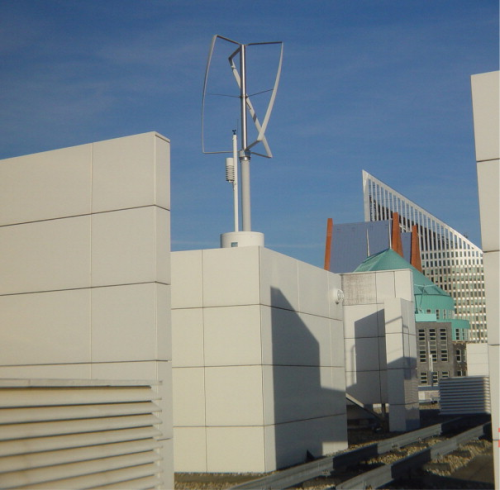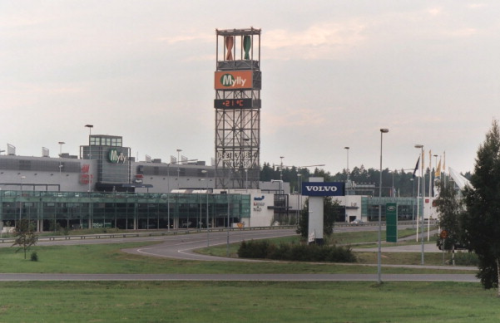


Claims of a potentially large market for urban wind turbines are really for the long term. Worldwide there has been little research published on the potential yield of micro wind turbines as compared to the giant wind turbines that march across California, the open lands of Germany or arrayed in the cold waters of the North Sea. There is also a lack of information on the new breed of aerodynamic, micro-multiple, almost office-fan sized US machines that sit along the edge of flat-roofed buildings.
Predicting the energy yield
According to a study by D. Simon J Watson of the Centre for Renewable Energy Systems Technology, Loughborough University, UK and Malcolm Heath and John Walsh of Power Technology ECON UK Ltd, there is a lack of experimental data available on the wind flows close to building walls, and a lack of design data available to designers and installers based upon an in-depth knowledge of the characteristics of urban wind flows. Current marketing literature typically quotes energy yields assuming a capacity factor of over 30 percent. This is far too optimistic, even for a carefully planned wind farm of megawatt sized turbines.
In the UK, government publication of offshore wind characteristics is of little use for urban wind turbine installations.
In 2007 the University of Loughborough sought to improve the available design data using what is known as a Mass Consistent computer model (NOABL). Early trials proved ineffective and the model has now been replaced with a methodology in which the UK Wind Atlas, along with variations of building shapes and layouts, together with the effects of wind from different directions of a wind rose weather map showing the frequency and strength of winds from different directions, became factors in a Computational Fluid Dynamic (CFD) modelling. This potentially gives energy yields that are closer to the truth of a location's micro-climatic shaping.
Wind energy equation
| Wind energy equation |
| Wind Power = ½ × (Swept Area of rotor) × Air Density × Wind Speed3 |
The wind energy equation in the box above implies that the higher the wind speed and to a much lesser extent, the higher the air density (the closer you are to sea level), the more available power there is from the wind.
However, the real world is far more complex than the theoretical world. The Reno, Nevada, based manufacturer of vertical wind turbines, Mariah Power Inc, has created an educational wind energy programme for experts as well as for school children. This includes an in-depth explanation of everything from atmospheric circulation patterns to predicting the yield, with the exact location a critical factor. However, while the company wants to give accurate wind profiles and estimates of derived power based upon geographical criteria for its customers, it suffers from a lack of data to do this.
Currently, across the growing worldwide industry of urban wind turbines, almost all studies of, say, turbulence, are undertaken on horizontal axis wind turbines and not vertical axis wind turbines (VAWT) – in which the vector components of turbulence interact differently and less satisfactorily.
Calculating the energy yield can be split into two halves:
- First, the mean energy speed in the area around the building where the turbine is installed must be estimated. This can be done by using visual references, data from weather stations, wind maps and the installation of an anemometer. With the latter cost is excessive unless scale of operation dictates otherwise;
- Second, a correction factor must be applied to allow for the local effect of the precise positioning of the turbine.
Differences of opinion
| "Currently, across the growing worldwide industry of urban wind turbines, almost all studies of, say turbulence, are undertaken on horizontal axis wind turbines and not vertical axis wind turbines (VAWT) - in which the vector components of turbulence interact differently and less satisfactorily." |
In the UK there are differences of opinion amongst local government planning authorities as to whether urban wind turbines can be mounted well above ridge heights. Obviously there is a need for education in the science of urban wind at local as well as national government levels, and from correspondence across the world, there seems to be a need for, not on a global and geographical site-specific scale.
There is a problem in measuring the roughness of an urban terrain as defined by the shaping, variable heights and density of buildings, together with the mixture of trees and other elements of urban planning. Factors of resistance need to be inserted into complex equations, and computer models are being created. In The Netherlands, the Dutch Meteorological Institute (KNMI) has compiled wind speed profiles above different terrain roughness, known as Stain Charts, for the whole country.
Turby BV, a highly-regarded Dutch manufacturer of VAWTs (see image on the right), is cooperating with the Institute of Wind Energy at Delft Technical University to calculate the wind speed distribution for energy yield at different heights and different terrain roughness across 100 areas of the country. This knowledge of precise wind speed distribution data at a proposed wind turbine height for a particular location (terrain roughness) is essential for a realistic power output of any given urban wind turbine.
Wind Energy 2007 – 10/271-287, published online by Wiley Interscience, gives a calculation process in which wind speed is combined with a turbine's power curve and the percentage frequency of the winds at each quadrant of the wind rose. On a test with a SWIFT 1.5kW HAWT, an annual energy yield was calculated as being 520 kWh. If some local planning constraint reduced the height of the wind turbine to some assumed aesthetical reasoning, then the annual yield could be reduced by a quarter to 108 kWh. This gives us an essential and elemental truth for the location of any urban wind turbine. The higher the wind turbine axial is above the ground the better the resulting annual energy yield.
The author takes a further step and proposes that the application of vertical axial wind turbines provide even better results. They use all the different directions of wind flow and are quieter in operation. As turbines they can be mounted in urban settings that, with the use of illumination, can become works of art.
The conclusions of the Loughborough University study of small building applications were:
- Yields in urban areas are likely to be low unless maximum operational heights are obtained after careful site selection;
- Wind speed-up effect seen above an isolated building is reduced when situated in an urban area;
- Flatter roof buildings tend to give greater wind speed-up than a pitched roof building [however, special architectural shaping on buildings can give a different dimension to this assertion.]
- Siting on buildings is critical and must be well above the roof line;
- Onsite measurement campaigns urgently need to validate predictions;
- The micro-wind urban turbine power curve needs to be tested to standard procedures.
Architectural Solutions
Urban wind turbines are currently seen as “stand-alone” products. They have their place in the creation of fully integrated nationwide energy strategies but it is also important that urban wind turbines are seen as part of ecological architectural design, as they interface with other micro and meso technologies such as solar skins and other environmental facades (and devices found on buildings with specific shapes).
Equally important is that technical consultants, energy advisers, architects and purchasing managers first take a total look at all the factors of influence that shape the design of a building.
| "Each building location has its own specific requirements and these should be addressed before any technical fix is made." |
Each building location has its own specific requirements and these should be addressed before any technical fix is made.
An aid for designers was created by the author in 1972 – known as ECHOES (Environmentally Controlled Human Operational Enclosed-External Space) where the spatial, luminous, sonic, thermal, matter and energy were interfaced with man's environmental relationship, passive and active controls [ref: Healthy Buildings: A design primer for a Living Environment by Holdsworth & Sealey. Longmans 1992].
Using this design system, integrated architectural technology solutions have been designed and developed over the past 50 years with some surprisingly good results – and which has kickstarted major new energy technologies.
The shaping of buildings dedicated to utilising the advantages of winds was developed by Dutch and British architects and engineers in 1998 with the revolutionary Schiedam Sun Mill. As a city-sense energy tower, its design has a majesty comparable to cathedral towers or the works of Victorian engineers such as Isambard Kingdom Brunel.
The integration of three, 29 metre propellers set into the façade of the Bahrain World Trade Centre is expected to generate 1300 MWhrs or some 15% of the building's energy requirements. This is an example of 'add-on' technology.
Integrated approaches
A more integrated approach will soon be seen on UK London's Vauxhall Bridge site where specially designed modular wind turbines are to be stacked and mounted on the top of the new Vauxhall Tower building, designed and manufactured by the Cornwall based company Wind Dam Ltd. Wind Dam has been short-listed for the 2009 Shell Springboard Award for technical innovations.
Further integration is to be encouraged. Tall buildings such as London's Gherkin already have a helical shape that, similar to the use of spiral fins on tall chimneys, helps to create vortical winds to increase flume emission heights and also become power drivers of turbines. The awareness that wind speed increases with height is fully appreciated by ecological architect Dr Ken Yeang, whose buildings stretch up into the skies of many world cities, using all types of integrated devices such as wind scoops, sails and shaping for both natural ventilation and as engines of power (Ref: Ecology of the Sky by Ivor Richards; Images 2001; See pages 170 – 180 WIND).
At a lower level of urban buildings where micro-wind turbine solutions are sought, beneficial use can be made of wind turbulence as it sweeps around the corners of buildings with the integration of vertical turbine elements. This is being developed at Durham University and NaREC by the British engineer Ken England of EMAT UK. (see http://root@emat.co.uk)
So far the emphasis has been with new build. Over the past three years, the Energy Systems Research Unit (ESRU) of Strathclyde University, Scotland, has developed a ducted wind turbine suitable for medium and high rise buildings. In addition, units with turbine blade diameters of 600 mm sit on the edge of a southwest facing roof on the Charles Rennie Mackintosh Lighthouse building on a hilly location in Glasgow, Scotland. The turbines utilise the up-draught of the moving airflow that impacts upon the buildings façade and is then scooped to flow across the turbines. An angled spoiler in the form of a PV module is added to create a pressure differential across the duct to increase flow speed.
It has been calculated that installing 10 units would yield in theory some 5400 kWh with the addition of 723 kWh from the PV modules. In real terms these figures would be lower, but the concept can prove beneficial. The university and ERSU are seeking partners to further the development.
The whole subject of interfacing wind with architectural solutions needs further investigation. The author would encourage readers of Renewable Energy Focus to send examples from across the world as a start to build up a database to expand and improve our knowledge and applications.
| About the author |
|
Bill Holdsworth is an independent consultant in the field of environmental + energy engineering and climatic adaptive technology. During his years as a design consultant, he has worked on projects worldwide that have included theatres, concert halls, hospitals, sports centres, schools, university buildings, offices and housing and early district heating systems. Innovative design work included wind and solar engineering as well Interseasonal heat energy storage, which has taken over 40 years to become accepted. He has also advised on sustainable strategies for the City of Zagreb, Fresno-California and Istanbul. In the past 12 years, he has worked on research projects with the University of Kingston-upon-Thames, UK and with the London Metropolitan University. Currently he has been engaged by the UK based international supermarket chain TESCO on developing new energy polices and technologies to enable the company to improve their responsibility to climatic impacts and global warming. His first undertaking was the in-depth study of Urban Wind Turbines that is summarised in this series of articles. Tel: 00 31 24 388 08 66. Email: William9@xs4all.nl |





